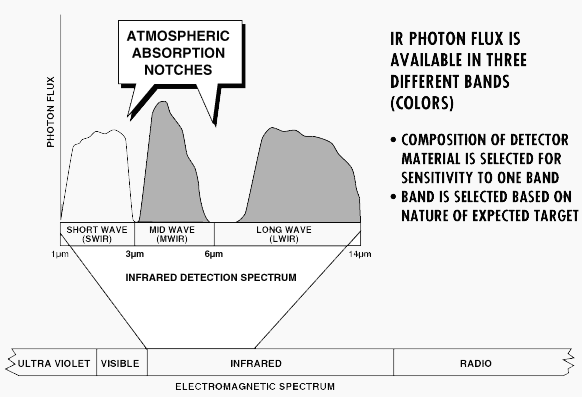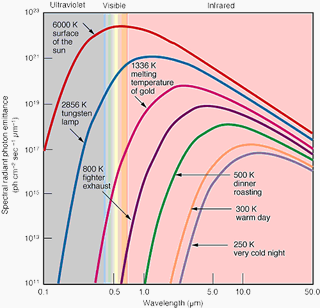|
||||||||||||||||||||||||||||||||||||||||||
|
||||||||||||||||||||||||||||||||||||||||||
Article: Infra Red Technology for Industrial Vision
Infra Red radiation
Infrared refers to that part of the electromagnetic spectrum beyond or above the red end of the visible color spectrum located between the visible and microwave regions. All objects radiate some infrared energy, even objects at room temperature and frozen objects such as ice. The higher the temperature of an object, the higher the spectral radiant energy, or emittance. Although much of the IR emission spectrum is unusable for detection systems, there are several wavelength bands with with good IR transmission.

The long wavelength IR (LWIR) band spans roughly 8-14 µm, with nearly 100% transmission on the 9-12 µm band. The LWIR band offers excellent visibility of most terrestrial objects.
The medium wavelength IR (MWIR or MIR) band (3.3-5.0 µm) also offers nearly 100% transmission, with the added benefit of lower, ambient, background noise.
Visible and short wavelength IR (SWIR or near IR, NIR) light (0.35-2.5 µm) corresponds to a band of high atmospheric transmission and peak solar illumination, yielding detectors with the best clarity and resolution of the three bands. Without moonlight or artificial illumination, however, SWIR imagers provide poor or no imagery of objects at 300K.
Infrared Detector
 An infrared detector is simply a transducer of radiant energy, converting radiant energy in the infrared into a measurable form. Infrared detectors can be used for a variety of applications in the military, scientific, industrial, medical, security and automotive arenas. Since infrared radiation does not rely on visible light, it offers the possibility of seeing in the dark or through obscured conditions, by detecting the infrared energy emitted by objects. The detected energy is translated into imagery showing the energy differences between objects, thus allowing an otherwise obscured scene to be seen.
An infrared detector is simply a transducer of radiant energy, converting radiant energy in the infrared into a measurable form. Infrared detectors can be used for a variety of applications in the military, scientific, industrial, medical, security and automotive arenas. Since infrared radiation does not rely on visible light, it offers the possibility of seeing in the dark or through obscured conditions, by detecting the infrared energy emitted by objects. The detected energy is translated into imagery showing the energy differences between objects, thus allowing an otherwise obscured scene to be seen.
Under infrared light, the world reveals features not apparent under regular visible light since hot objects such as people stand out from the typically cooler backgrounds regardless of the available visible light. People and animals are easily seen in total darkness, weaknesses are revealed in structures, components close to failure glow brighter, visibility is improved in adverse condition such as smoke or fog.
NIR InGaAs Detector
XenICs, a rapidly growing high-tech company based in Belgium, has become the industry leader in Infra Red technology for machine vision applications. XenICs has been able to impress with their superb scientific background in infrared (IR) technology and serves the machine vision market with a range of excellent products.
XenICs has developed InGaAs detectors that offer a spectral range of 0.9 - 1.7 µm, 1.0 - 2.2 µm and 1.0 - 2.5 µm. The very beneficial extension from 1.7 µm to 2.2 µm and 2.5 µm is accomplished by varying the fraction of indium in the ternary compound. Introducing indium into GaAs decreases the bandgap of the compound and enables the detection of infrared radiation of longer wavelengths.
Most IR materials are fabricated lattice-matched, meaning: on a substrate that has the same lattice constant as the IR material itself. For III-V compounds, the most commonly used substrates are GaAs, InP, InAs, GaSb and InSb. The InGaAs alloy with a 1.7 µm cut-off wavelength is lattice matched to InP. Therefore it is generally fabricated on InP substrates. In order to extend its sensitivity to longer wavelengths, the alloy has to be fabricated on a lattice-mismatched substrate. This can be done on an InP substrate or on a standard GaAs substrate.
Using the lattice matched and mismatched technology, state of the art InGaAs linear arrays as well as focal-plane-array (FPA) detectors have been fabricated.
Uncooled Bolometers
 Uncooled
bolometers consist of thermally isolated microbridges, with a temperature
sensitive material deposited on top. The temperature sensitive material
can be V2O5, a-Si or poly-SiGe. The microbridges are surface-micromachined
directly on the CMOS circuits.
Uncooled
bolometers consist of thermally isolated microbridges, with a temperature
sensitive material deposited on top. The temperature sensitive material
can be V2O5, a-Si or poly-SiGe. The microbridges are surface-micromachined
directly on the CMOS circuits.
Combining thermal detector elements with an integrated circuit raises the problem of interfacing the detector elements and the IC. One of the more serious problems arises because thermal detector elements must be heated, or allowed to cool, due to the radiation to be detected. Therefore, for optimum performance, the detectors must be thermally isolated from their surroundings. This precludes the simple depositing or mounting of the detectors directly on the IC - because Si is a good thermal conductor. Otherwise, the detectors would become so thermally loaded that it would adversely affect their performance as thermal detectors.
Therefore, the microbridges are surface-micromachined directly on the CMOS circuits. This permits the fabricating of contact supports that establish a compromise between a good electrical contact, which is needed to read out the detector element, and a poor thermal contact, which prevents thermal leakage of the absorbed radiation.
Infrared Detector types and Materials
Photon Detectors |
Energy Detectors |
||
Intrinsic, PV |
- MCT |
Bolometers |
- Vanadium Oxide (V2O5) |
- Si, Ge |
- Poly-SiGe |
||
- InGaAs |
- Poly-Si |
||
- InSb, InAsSb |
- Amorph Si |
||
Intrinsic, PC |
- MCT |
Thermopiles |
- Bi/Sb |
- PbS, PbSe |
Pyroelectric |
- Lithium Tantalite (LiTa) |
|
Extrinsic |
- SiX |
- Lead Zirconium Titanite (PbZT) |
|
Photo-emissive |
- PtSi |
Ferro-electric |
- Barium Strontium Titanite (BST) |
QWIP |
- GaAs/AlGaAs |
Micro cantilever |
- Bimetals |
Many of these IR materials are based on compound semiconductors made of III-V elements such as indium, gallium, arsenic, antimony, or on the II-VI elements mercury, cadmium and telluride, or on the IV-VI elements lead, sulfur and selenide. They can be combined into binary compounds such as GaAs, InSb, PbS and PbSe or into ternaries such as InGaAs or HgCdTe.
Applications
Typical uses of advanced XenICs IR cameras as night-vision scopes in public environments and/or governmental applications are perimeter and border patrol, and in specific reconnaissance and surveillance missions. There are also concepts for enhancing drivers' vision in night-time driving under rain and fog conditions using light-weight IR imaging systems.
Just opening up is an attractive potential for XenICs IR systems in monitoring the operational safety of land-based commercial fleets and vehicles, and seagoing vessels such as ferry boats and yachts. Ever more important is guaranteeing the continuous security of ports and airports and their protection against extrinsic disturbances - such as in detailed cargo control - which also pertains to safeguarding sensitive industrial facilities and power plants.
Another promising development based on widespread utilization of thermal imaging covering dense urban zones is traffic monitoring and flow management according to actual vehicle and passenger counts traveling certain roads.
XenICs Infrared cameras and systems will find future commercial uses in EVS aircraft landing assistance systems, thereby increasing passenger safety and traffic capacity of heavily frequented airports.
Direct industrial applications of XenICs cameras include research and development projects in all engineering professions, real-time process monitoring in high-temperature manufacturing processes, aircraft maintenance in regard to the performance of electrical, hydraulic und pneumatic systems' malfunctions, such as turbine inspection.
Focal plane arrays in telecom and data traffic infrastructures: The increasing amount of video and data traffic is driving the deployment of high-capacity dense wavelength division multiplexing (DWDM) networks. Multiple optical channels must be closely monitored to identify and correct degradations in optical signal quality. XenICs Linear InGaAs arrays can be used to determine the optical power, wavelength and signal-to-noise ratio of each channel. DWDM monitoring is a hot application of optical detectors in the telecom industry. Other applications of InGaAs focal plane arrays in the telecom industry can be found in laser beam profiling and inspection of laser versus fiber alignment.
An interesting non-technical application for IR imaging systems is in the analysis and validation of art works such as paintings and sculptures in terms of their genesis, provenance and restoration status.
Space and astronomy applications are a given field for radiometric systems, as are medical applications where IR imaging serves as a supporting tool in diagnostic procedures and as a safeguard against dangerous radiation impacts. Connected with this area is forensic investigation.
Another wide range of advanced scientific applications of IR imaging and thermography is currently opening up, such as in the observation and measurement of ultra-high speed, high-temperature processes and phenomena.
Adept Electronic Solution (AES) is the specialist Australian and New Zealand distributor of machine vision systems and image analysis software. With a broad range of world class machine hardware and software products, AES provides a complete machine vision systems solution.
Consult one of our expert machine vision specialists today at Tel Sydney (02) 99792599 / Perth (08) 92425411 / Melbourne (03) 95555621
For more information please contact us.
|
If you like this page, please recommend and share it. |
|||
| More | |||



